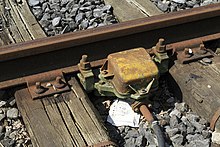Track closer
Track closers register the passage by a vehicle . They are used to trigger switching processes such as switching on and off crossing safety systems by moving trains or to make operator actions dependent on the cooperation of the train. The track closer switches when overflowing through the first axis . Must be ensured that switching processes are triggered only when the train the Zugeinwirkungsstelle loaded and has completely moved clear, then you have the rail contact by a linearly acting criterion as an isolated track to be added. Typical cases are the triggering of the electrical route key lock, which may only take place when the train has cleared the protective section behind an entry signal, and the route clearance, for which the train must have left the last switch.
function
The contact reacts to the elastic deflection of the rail due to the pressure applied by a wheel set. If the axle is in the sleeper compartment in front of the contact, the lever will bend upwards. If the sleeper compartment itself is driven on, it bends at the bottom and back up in the next sleeper compartment.
Designs
In the area of Deutsche Bahn there are still two pneumatically operating designs to be found: the S44 rail contact (contact insert with double valve) and the Neptun rail circuit closer with a (U- or V-shaped) mercury contact tube, the S44 having a changeover contact, whereas the Neptun rail circuit closer each has a break contact and a make contact. Common to both types is the function of an overpressure and a vacuum chamber. The contacts are hung in the sleeper compartment with four screws under the rail foot. In the middle, a pressure piece transfers the deflection of the rail to the membrane between the overpressure and the underpressure chamber. The pressure difference moves the mercury in the switching tube or the mechanical changeover contact.
The fundamental disadvantage of track closers is that the principle no longer works reliably enough with heavy tracks or vehicles that are too light. An axle pressure of at least 1.75 tons is required. This resulted in the special regulations for the implementation of small car trips on the open route. When installing heavier rail profiles than the S 49, existing rail current closers must be replaced by track switching devices with different operating principles such as magnetic rail contacts or Tf track circuits.
literature
- Collective of authors under the direction of Hans-Jürgen Arnold, Eisenbahnsicherungstechnik , transpress Verlag für Verkehrwesen, Berlin 1987
